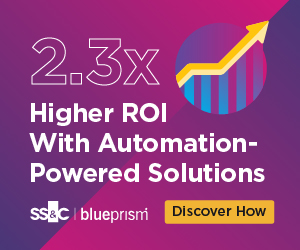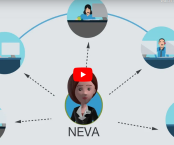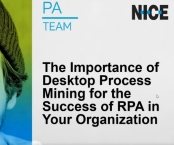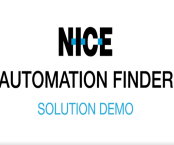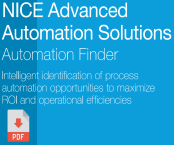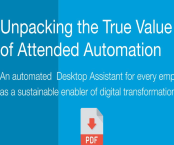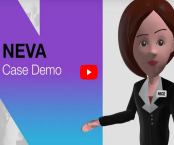
In the late 1980s, as call centers were becoming the main point of customer service contact for organizations, NICE was founded to offer solutions for recording those interactions. When the company evolved the technology underlying those solutions to include automation, it found other applications that would benefit and expanded its focus beyond just contact centers.
Since then, NICE has grown organically and via acquisitions into a $1.6 billion enterprise offering a range of services including its original contact center recording, workforce optimization, speech and desktop analytics, cloud-based CX platforms and process automation.
Recently, RPA Today sat down with Barry Cooper, NICE’s president of workforce engagement and customer experience to talk about how the pandemic is affecting the adoption of automation technology, how that adoption impacts an organization’s employees, and the role attended automation will play moving forward.
RPA Today: Employment numbers suggest people are not going back to work post-pandemic as quickly as many thought they would. Has automation contributed to that?
Barry Cooper: Looking at the world of customer service as one example, things have undoubtedly changed permanently as a result of the pandemic. Many in-person branches have closed their doors, never to reopen, and self-service has become more important than ever. The type of service that people consume in self-service channels, however, usually encompasses simpler and more standardized requests, while more complex ones still end up as contact center calls.
As a result, customer service agents are facing more complex customer requests and their jobs are more stressful than ever. Agents need to handle processes that are more critical to the customer and enterprise alike (e.g., mortgage approvals), while easier requests like PIN number resets are handled online. On top of that, agents working remotely don’t have access to the level of support they had from managers and peers when working in the physical call center environment. This trend could be a cause of higher employee attrition.
NICE calls this the High Stakes Agent. Automation helps the High Stakes Agent become more successful by taking away more routine tasks and reducing the complexity of processing customer requests. In this model, automation doesn’t replace people but rather supports them and enables them to meet their KPIs. By embedding automation into daily work routines and taking away tasks employees never enjoyed doing, companies can make their employees happier and more engaged, and increase employee retention.
RPA Today: With this trend, how do you see NEVA being used in remote Customer Service Contact Center applications.
Barry Cooper: NICE was at the forefront of the process optimization/automation revolution, even before it was known as RPA. With its attended automation solution (i.e., robots on the employee’s desktop), it extends automation from the back-office to the front-office, in turn elevating the scale and value of an organization’s automation effort. As employees’ personal assistants, attended robots help them to perform their work faster and more accurately, while providing them with on-screen guidance when they are unsure of the next step in a process or of a compliance-related script or action.
By giving the employee a digital personal assistant on their desktop, attended automation brings the benefits of automation to administrative processes that are more complex and less standardized than those usually handled in RPA. During the pandemic, attended automation also helps fill some gaps in remote working. Managers can use desktop bots to present critical management updates on-screen when employees log on. When employees work remotely, it is harder to support them with coaching and training. This is another area where attended automation can help by providing on-the-job training through real-time guidance and automation capabilities.
RPA Today: NICE has chosen to focus on developing solutions in the attended automation space. What makes that opportunity more exciting for you than unattended automation?
Barry Cooper: In the age of the High Stakes agent, the human workforce is becoming more, rather than less, important. Even if automation displaces the need for humans to carry out some tasks and processes, it is not yet at a stage that it can provide high-quality service for customers who call in with less routine or more complex queries. Chat and voice bots can resolve many simple issues, but when the interaction or service request is more complex, people still want to speak to a human agent. This isn’t going to change in the near future.
Bots are getting smarter with AI solutions such as Enlighten XO from NICE. However, they are not yet up to offering the empathy and creative solutions customers are seeking when they phone in with a unique or sensitive issue. Attended automation helps humans perform at their best – in the contact center or the back office. Our goal at NICE is to help people become better versions of themselves, and help enterprises provide truly exceptional service.
RPA Today: The business verticals that have benefited most from RPA until now are well known (e.g., finance/banking, insurance, health care, government) What are the next business verticals that should be thinking about automation?
Barry Cooper: It’s not as much about the vertical market an enterprise plays in as it is about its size and maturity. Banks, insurers, public-sector organizations and other larger enterprises that computerized decades ago were quick to see the opportunities of using RPA in their back-offices. They are using RPA to glue together their legacy systems and their newer business applications.
The next wave of automation is about using attended automation robots in the front-office, especially the contact center. The scale of the implementations we are seeing in contact centers is bigger than those we have seen before – some customers have more than 30,000 bots. They are playing a key role in helping agents in many contact centers cope with surging call volumes and more complex interactions in the pandemic.
RPA Today: Do you think organizations need some kind of training on how to communicate with their employees about automation? What should their message be as they implement technology that could affect the job security of their staff?
Barry Cooper: Depending on the organization, there may be some resistance in the workforce to using RPA or attended automation to carry out tasks that humans once performed. Many workers are anxious at first that their roles will be replaced by a machine or that robots will take over parts of their job they find meaningful. We believe it is important to drive a change management program alongside any automation program, with the goal of communicating how an employee’s role will evolve and how they will benefit from working alongside automated systems.
It’s a good practice to get employees involved in process automation. We believe that RPA works best when used to augment human potential. As such, companies get the best results when they work with employees to identify which processes to automate: the ones that are boring and repetitive for the employee, that impair the customer experience, and that drain productivity and efficiency. Automating in a way that frees people from drudge work and lets them focus on customer experience and problem-solving helps to drive successful adoption of the technology.
If you liked this article, please sign up to RPA Today! Registrants will receive our free weekly RPA newsletter updating you on the most recent developments in the Robotic Process Automation, Intelligent Automation and AI space. In addition to news updates, we will also provide feature articles (like this one) with a more in-depth examination of RPA issues for end users and their enterprises.

